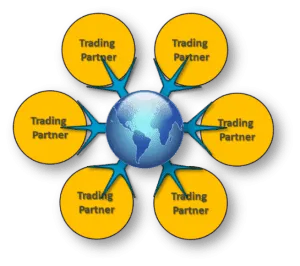VAN Independence: How Does a Trading Partner Break from Its VAN?
What’s Your VAN Independence Strategy?
Independence Day is now behind us and summer is nearing its end. The 4th of July holiday encourages reflections, reflections that include independence and country. It also includes independence in financial, personal, and business matters. Returning to work following the mid-summer holiday this year, I began to think about systemic independence – specifically the independence of trading partners who are more willing than ever to declare themselves independent from their VAN.
A value-added network (VAN) is a private network used by a company to facilitate and ensure the exchange of EDI transaction documents with one or more trading partners.
Communication
Traditional EDI includes costs of configuration, transformation, integration, and communication. EDI communication typically includes the use of a VAN. EDI requires a mechanism that allows trading partners to send and receive messages. While there are other methods, the VAN is the most conventional one.
There are many such VANs available, typically through subscriptions. These VANs communicate with members as well as among each other, allowing VAN subscribers to communicate with one another regardless of the community to which they belong.
Foundation
The original VANs were much more than what service-based organizations associated with a transport mechanism. Many began their lives as services associated with “computing time” back when computers were rare and the needs for computing were greater. Companies like IBM set up massive communication channels using the IBM Systems Network Architecture (SNA) to facilitate the use of mainframe computers; such interactions and transaction exchanges were subsequently moved to smaller and smaller machines using File Transfer Protocol (FTP).

Domination
Once in place, VANs began reducing the services they provided. No longer providing computing services, they set their sights on becoming massive communication channels. They set up their own independent communications networks, complete with “mailboxes” and “interconnects”. The mailbox was an address on a VAN used by a trading partner to pick up and drop off transaction documents. On the other hand, the interconnect was a tool used by VANs to communicate with other independent VANs to help delivery and exchange of transaction documents.
Substitution
Once in place, VANs began reducing the services they provided. No longer providing computing services, they set their sights on becoming massive communication channels. They set up their own independent communications networks, complete with “mailboxes” and “interconnects”. The mailbox was an address on a VAN used by a trading partner to pick up and drop off transaction documents. On the other hand, the interconnect was a tool used by VANs to communicate with other independent VANs to help delivery and exchange of transaction documents.
So why aren’t more companies moving to AS2? It may be because no one has explained the benefits in a way that makes a comparison easy.
Explanation
AS2 securely moves more data at a lower cost by relying on Internet access rather than a dedicated network. The VAN’s monthly access fees and kilo-character costs disappear.
AS2 relies on software and the Internet to accomplish the same tasks that were once only found in the domain of VANs.

Erosion
Market consolidation of EDI products and services has recently seen a consolidation of VANs, with many of the impacted customers moving toward AS2. Considering the growth rates we saw in the use of “free email” in the browser wars of the 1990s, industry experts agree that AS2 is likely to become more like FTP in its frequency of use.
What’s the Lesson?
EDI buyers will look for an EDI solution that:
- Offers independence from the VAN, can leverage any type or number of independent connections, and is in tune with today’s market
- Has a willingness to go that extra mile for their business
- Provides improved service offerings at a fixed cost and includes everything they need to make it work
- Integrates directly with their ERP, works without manual intervention, and helps them be more efficient.
Questions to Ask Your Client
- Are you happy with your current EDI solution?
- Is your EDI solution integrated or does it require manual intervention like logging into a portal, uploading spreadsheets, or running a batch process to make it work?
- Are you using multiple solutions to communicate with your trading partners?
- How would you like to break from these dependencies?
- Would you be interested in hearing about a frictionless EDI solution?
 PartnerlinQ
PartnerlinQ







